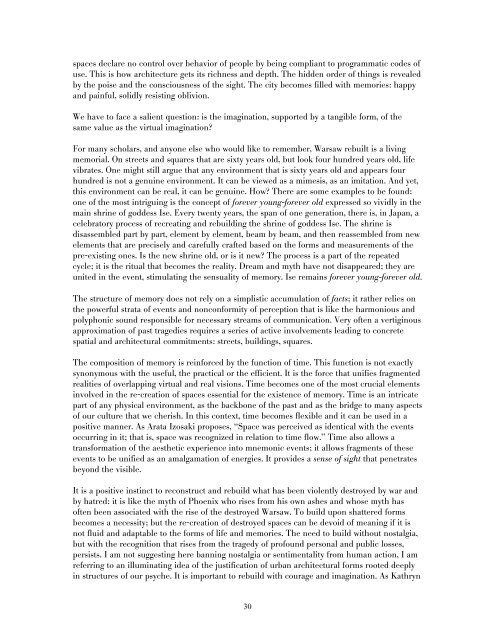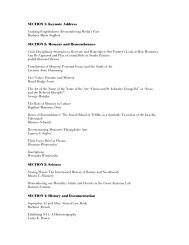the aesthetic equivalent - Directory Listing Not Here - School of ...
the aesthetic equivalent - Directory Listing Not Here - School of ...
the aesthetic equivalent - Directory Listing Not Here - School of ...
You also want an ePaper? Increase the reach of your titles
YUMPU automatically turns print PDFs into web optimized ePapers that Google loves.
spaces declare no control over behavior <strong>of</strong> people by being compliant to programmatic codes <strong>of</strong><br />
use. This is how architecture gets its richness and depth. The hidden order <strong>of</strong> things is revealed<br />
by <strong>the</strong> poise and <strong>the</strong> consciousness <strong>of</strong> <strong>the</strong> sight. The city becomes filled with memories: happy<br />
and painful, solidly resisting oblivion.<br />
We have to face a salient question: is <strong>the</strong> imagination, supported by a tangible form, <strong>of</strong> <strong>the</strong><br />
same value as <strong>the</strong> virtual imagination?<br />
For many scholars, and anyone else who would like to remember, Warsaw rebuilt is a living<br />
memorial. On streets and squares that are sixty years old, but look four hundred years old, life<br />
vibrates. One might still argue that any environment that is sixty years old and appears four<br />
hundred is not a genuine environment. It can be viewed as a mimesis, as an imitation. And yet,<br />
this environment can be real, it can be genuine. How? There are some examples to be found:<br />
one <strong>of</strong> <strong>the</strong> most intriguing is <strong>the</strong> concept <strong>of</strong> forever young-forever old expressed so vividly in <strong>the</strong><br />
main shrine <strong>of</strong> goddess Ise. Every twenty years, <strong>the</strong> span <strong>of</strong> one generation, <strong>the</strong>re is, in Japan, a<br />
celebratory process <strong>of</strong> recreating and rebuilding <strong>the</strong> shrine <strong>of</strong> goddess Ise. The shrine is<br />
disassembled part by part, element by element, beam by beam, and <strong>the</strong>n reassembled from new<br />
elements that are precisely and carefully crafted based on <strong>the</strong> forms and measurements <strong>of</strong> <strong>the</strong><br />
pre-existing ones. Is <strong>the</strong> new shrine old, or is it new? The process is a part <strong>of</strong> <strong>the</strong> repeated<br />
cycle; it is <strong>the</strong> ritual that becomes <strong>the</strong> reality. Dream and myth have not disappeared; <strong>the</strong>y are<br />
united in <strong>the</strong> event, stimulating <strong>the</strong> sensuality <strong>of</strong> memory. Ise remains forever young-forever old.<br />
The structure <strong>of</strong> memory does not rely on a simplistic accumulation <strong>of</strong> facts; it ra<strong>the</strong>r relies on<br />
<strong>the</strong> powerful strata <strong>of</strong> events and nonconformity <strong>of</strong> perception that is like <strong>the</strong> harmonious and<br />
polyphonic sound responsible for necessary streams <strong>of</strong> communication. Very <strong>of</strong>ten a vertiginous<br />
approximation <strong>of</strong> past tragedies requires a series <strong>of</strong> active involvements leading to concrete<br />
spatial and architectural commitments: streets, buildings, squares.<br />
The composition <strong>of</strong> memory is reinforced by <strong>the</strong> function <strong>of</strong> time. This function is not exactly<br />
synonymous with <strong>the</strong> useful, <strong>the</strong> practical or <strong>the</strong> efficient. It is <strong>the</strong> force that unifies fragmented<br />
realities <strong>of</strong> overlapping virtual and real visions. Time becomes one <strong>of</strong> <strong>the</strong> most crucial elements<br />
involved in <strong>the</strong> re-creation <strong>of</strong> spaces essential for <strong>the</strong> existence <strong>of</strong> memory. Time is an intricate<br />
part <strong>of</strong> any physical environment, as <strong>the</strong> backbone <strong>of</strong> <strong>the</strong> past and as <strong>the</strong> bridge to many aspects<br />
<strong>of</strong> our culture that we cherish. In this context, time becomes flexible and it can be used in a<br />
positive manner. As Arata Izosaki proposes, “Space was perceived as identical with <strong>the</strong> events<br />
occurring in it; that is, space was recognized in relation to time flow.” Time also allows a<br />
transformation <strong>of</strong> <strong>the</strong> aes<strong>the</strong>tic experience into mnemonic events; it allows fragments <strong>of</strong> <strong>the</strong>se<br />
events to be unified as an amalgamation <strong>of</strong> energies. It provides a sense <strong>of</strong> sight that penetrates<br />
beyond <strong>the</strong> visible.<br />
It is a positive instinct to reconstruct and rebuild what has been violently destroyed by war and<br />
by hatred: it is like <strong>the</strong> myth <strong>of</strong> Phoenix who rises from his own ashes and whose myth has<br />
<strong>of</strong>ten been associated with <strong>the</strong> rise <strong>of</strong> <strong>the</strong> destroyed Warsaw. To build upon shattered forms<br />
becomes a necessity; but <strong>the</strong> re-creation <strong>of</strong> destroyed spaces can be devoid <strong>of</strong> meaning if it is<br />
not fluid and adaptable to <strong>the</strong> forms <strong>of</strong> life and memories. The need to build without nostalgia,<br />
but with <strong>the</strong> recognition that rises from <strong>the</strong> tragedy <strong>of</strong> pr<strong>of</strong>ound personal and public losses,<br />
persists. I am not suggesting here banning nostalgia or sentimentality from human action, I am<br />
referring to an illuminating idea <strong>of</strong> <strong>the</strong> justification <strong>of</strong> urban architectural forms rooted deeply<br />
in structures <strong>of</strong> our psyche. It is important to rebuild with courage and imagination. As Kathryn<br />
30








